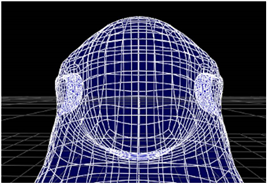Importing ABC Meshes and Point Clouds
You can import meshes (or NURBS curves/patch surfaces converted to meshes) and point clouds from Alembic files (.abc file format) into a Nuke scene. During the import, Nuke allows you to control which nodes in the Alembic scene get loaded by using an import dialog. If there is only one item in the Alembic file, it loads automatically. Below is an example of an imported octopus Alembic file, courtesy of Sony Pictures Imageworks.
In addition to meshes and point clouds, you can also import cameras and transforms from Alembic files. See Importing Cameras from Alembic Files and Importing Transforms from Alembic Files for more information.

For more information on Alembic, see http://code.google.com/p/alembic/
Note: To learn how to export files in the Alembic (.abc) format, refer to Exporting Geometry, Cameras, Lights, Axes, or Point Clouds for more information.
To Import Meshes and Point Clouds from an Alembic File
| 1. | Click Image > Read or press R on the Node Graph. |
The Read File(s) dialog displays.
| 2. | Select the .abc file you want to import from the file location, then click Open. |
• Files containing only one object are loaded automatically into a ReadGeo node in the Node Graph.
• Files containing more than one object display a scenegraph load dialog that allows you to create separate ReadGeo nodes from parents in the scenegraph. By default, all items are selected in the scenegraph.

Selected parent items are indicated by an orange circle, and selected child items by an orange bar (these turn gray when you select them in the list). Unselected items are indicated by a dot in the Load column.
| 3. | To import specific items, deselect the root item by clicking on the orange circle. This de-selects the root and any child items. |
| 4. | Select the required items in the scenegraph by clicking on the dots against the items you want to import. |

Alternatively, you can right-click on an item and select:
• select as parent - select this item and make it a parent. This allows you to create a separate ReadGeo node for this item and any child items.
• select as child - select this item and make it a child to the nearest parent item up the tree.
• deselect - deselect this item so that it is not imported.
You can also select multiple items by pressing Ctrl/Cmd or Shift while clicking them.
| 5. | Do one of the following: |
• Click Create all-in-one node to create one ReadGeo node for everything that’s selected, regardless of whether the items are selected as parent or child.
• Click Create parents as separate nodes to create one ReadGeo node for each parent item marked with an orange circle in the scenegraph. Each ReadGeo node also contains all child items.
Tip: If you always want .abc files to import all-in-one without displaying the import scenegraph, enable Preferences > Behaviors > File Handling > always load abc files as all-in-one.
Nuke creates ReadGeo, Camera, and Axis nodes as necessary, depending on what you chose to import from the scene.
| 6. | In the ReadGeo node Properties panel, you can adjust the following: |
• If the objects you imported are animated, make sure read on each frame is checked. This preserves the animation. When read on each frame is disabled, use lock frame to select the frame the object is loaded at.
• If you don’t want to render motion blur, disable sub frame for faster UI interactions.
• In the frame rate field, define a frame rate (frames per second) to sample the animation curves.
• Use render points as to determine how point primitives are rendered: either as Nuke point clouds or Nuke particles.
• Enable use geometry colors to apply geometry color attributes read from .abc files and apply them to the Nuke geometry.
Note: When disabled, this control can cause differences in rendered output when compared to previous versions of Nuke. If this occurs, enable use geometry colors in the ReadGeo Properties panel.
• Any mesh items imported are listed on the Scenegraph tab of the ReadGeo node. To display all items that exist in the Alembic file in the list, check view entire scenegraph. This allows you to add items to the list or remove them from it by clicking on the indicators in the Load column.
Tip: To load specific items from an Alembic file, you can also create a ReadGeo, Camera, or Axis node, check read from file, and click the folder icon on the File tab to browse to an .abc file.
